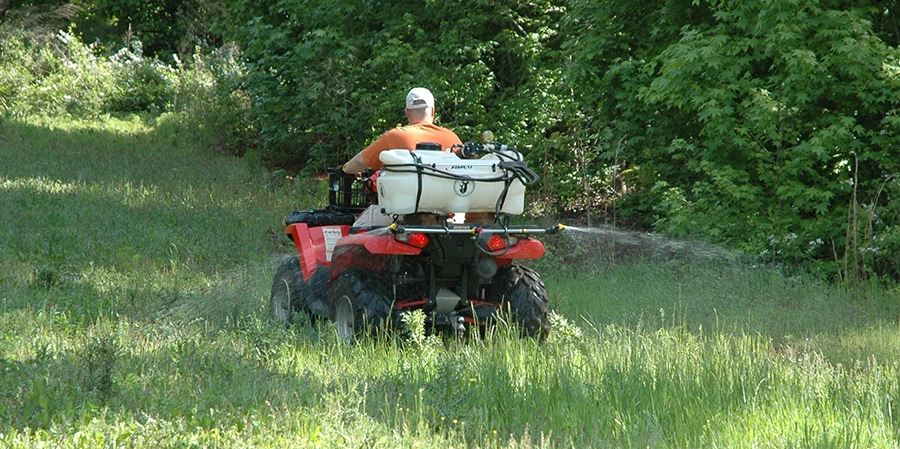 Let’s face it, food plots are a lot of work. They can also be costly when you consider the seed, lime, fertilizer, as well as the fuel needed to keep the tractor or ATV running. The last thing you want is to invest your valuable time and hard-earned money on a food plot only to have it taken over by weeds.
Let’s face it, food plots are a lot of work. They can also be costly when you consider the seed, lime, fertilizer, as well as the fuel needed to keep the tractor or ATV running. The last thing you want is to invest your valuable time and hard-earned money on a food plot only to have it taken over by weeds.
Fortunately, many potential weed issues can be avoided with proper site selection and site preparation. And when weeds do arise, the problem can sometimes be controlled with mechanical means such as mowing. However, even under ideal circumstances, weeds can still become enough of an issue that the only viable option is an herbicide treatment.
In a previous article, we discussed common herbicide terms. Understanding these terms will go a long way in helping you select the right herbicide for your specific application. While there are hundreds of different herbicides on the market, most food plot weed control can be handled with just a handful of the most common ones. Let’s take a look at five of those popular herbicides, along with when you’d use each one.
Kill Them All (the Weeds, That Is)
Glyphosate Commonly referred to by its original trade name Roundup, glyphosate is undoubtably the most commonly used when it comes to planting food plots. It is a non-selective herbicide, meaning that it can potentially kill any plant it contacts. That, coupled with it being relatively inexpensive, makes it a great choice for killing the existing vegetation in a food plot prior to planting. Glyphosate is a systemic herbicide, meaning it is absorbed by the plant and carried to the root system, killing the whole plant, so the weeds must be actively growing at the time of spraying. Glyphosate does not remain active in the soil, so it will not prevent additional weeds from germinating.
Another factor making glyphosate popular for food plots is the availability of certain crops, such as corn and soybeans, in a glyphosate-resistant variety. These are often labeled as “Roundup Ready.” This allows you to spray glyphosate right over your actively growing corn or soybeans, and only the weeds growing in the plot will be negatively impacted.
As with any herbicide, be sure to use glyphosate according to label guidelines, as misuse or overuse can result in glyphosate resistance among some weeds.
If Grasses are an Issue
Sethoxydim Sethoxydim is most commonly known by the trade name Poast, but may be available under a variety of others (Poast Plus, Vantage, Sethoxydim G-Pro). Unlike glyphosate, sethoxydim is a selective herbicide, meaning that it only controls specific weeds. In this case, the herbicide targets grasses while not damaging broadleaf plants. It is also a systemic herbicide, so it must be sprayed on young, actively growing grass weeds, and it will not remain active in the soil after spraying. In food plot plantings, sethoxydim is commonly used to control grasses in legume and brassica plantings.
Clethodim Clethodim is very similar to sethoxydim in that it is a grass-specific, selective herbicide. It is often purchased under the trade names Arrest Max, Arrow or Select. It performs similarly to sethoxydim, however clethodim seems to do a better job of controlling johnsongrass. So, if johnsongrass is a problem in your plot, you may want to opt for clethodim. If not, you can base your herbicide selection between the two on price and availability.
Because of the way sethoxydim and clethodim work, they are relatively slow killers, often taking several weeks to completely knock back the grasses in a food plot. Don’t get discouraged when you don’t see obvious results in the first two weeks.
If Broadleafs are the Problem
2,4-D If you are trying to grow a plot with grasses such as wheat, rye, oats, grain sorghum, or corn and you have an issue with broadleaf weeds, then 2,4-D may be your best option. 2,4-D is a common selective herbicide that controls broadleaf weeds without harming grasses — as long as it is used according to label recommendations. 2,4-D is readily available at most farm supply stores and co-ops under a variety of trade names. Like the other herbicides discussed in this article, it is systemic, so weeds need to be actively growing when they are sprayed. While 2,4-D breaks down relatively quickly, it can remain active in the soil for one to four weeks, so keep this in mind if you will be planting any broadleaf species in the area soon after spraying.
2,4-DB (butyrac) While 2,4-DB, or butyrac as it is sometimes referred to, is very similar to 2,4-D with one very important difference: it will not kill certain legumes such as many common species of clover and alfalfa when applied correctly. This makes it a great choice for controlling broadleaf weeds in pure stands of clover or in mixes of clover and cereal grains (wheat, rye, and/or oats). Do not use 2,4-DB if the mix contains brassicas, chicory or other broadleaf forbs, as they will likely be damaged or killed.
Summary
Controlling weeds in food plots is a common issue and one that often requires a multifaceted approach for the best results. The key to being prepared is knowing what weeds you are likely to encounter in your specific area and having a plan of attack ready when those issues arise. While these five herbicides will handle a lot of the common food plot weed problems, there are plenty of other herbicide options out there. It is best to consult with a professional when possible, and always follow the recommended rates and application directions on the herbicide label.











































